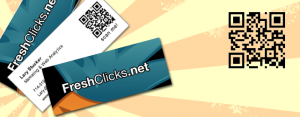 QR Code stands for “Quick Response” and are 2D codes that are readable by smart phones and other scanners. The cool thing about these QR Codes is you can transmit all kinds of data through them, like contact information, or your websites. Since they are still fairly new, and so many people have smart phones, the novelty of having a QR Code on your business card is sure to get used and will drive traffic to your website.
QR Code stands for “Quick Response” and are 2D codes that are readable by smart phones and other scanners. The cool thing about these QR Codes is you can transmit all kinds of data through them, like contact information, or your websites. Since they are still fairly new, and so many people have smart phones, the novelty of having a QR Code on your business card is sure to get used and will drive traffic to your website.
I just added QR Codes to a new batch of business cards for Fresh Clicks so I figured I’d walk you through the process, so that you can create your own:
- Tag your URL: I wouldn’t be much of a marketer if I didn’t recommend adding tracking code to your hyperlink. If you use Google Analytics, tagging your link is easy. Just hop on over to Google’s URL builderand plug in your information. I added the following values, but feel free to add whatever you want:
- Campaign Source: mini (I chose “mini” because these particular cards were moo mini cards)
- Medium: business card
- Campaign Name: QRcode
- Create a shortened URL: QR Codes get more complicated as you add more data. To make it easier for smart phones to read your code, you should use a URL shorting service. You can use bit.ly or any number of other URL shortening services. I recommend using Google’s URL shortnerfor two simple reasons:
- It’s Google, so you know they are going to be around for a while
- The .gl extension is a domain of Greenland and not Lybia, like the .ly extension in bit.ly. Many have argued, just like Arron Pigeon in his article “Why investing in Bitly last week was a bad idea“, that the .ly extension is a risky bet because Lybia could pull the plug whenever they want.
- Create your QR Code: There are plenty of free QR Code generators out there but I liked using the KAYWA QR Code generator. It was easy to use, didn’t have a lot of complicated options, and it generated a large QR Code (324px × 324px) in PNG format. You could just add a .qr to the end of your newly shortened Goo.gl link like this, goo.gl/KPWVm.qr, but I wasn’t happy with the code it created. The pixel size was a bit low, and though I couldn’t be sure, it seemed like the QR Code it generated was more complicated than the one from KAYWA.
- Creating your business cards: For this batch of cards I decided to use the moo mini cards. I have been very happy with the quality of their service and the mini cards are another great way to set you apart. You have the option of uploading a different image on every card, and you can add your QR Code to the back with your standard contact info. You have to be careful not to make your QR Code too small. It is recommended that your don’t make it smaller then 0.70 inches. To make it easier I’ve created a Photoshop MiniMoo Back Template Card QR Code for you to use.
If you end up adding a QR Code to your business card make sure you let me know about it! Have fun, and happy scanning!